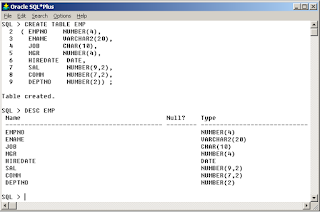Structured Query
Language(SQL) as we all know is the database
language by the use of which we can perform certain operations on the existing
database and also we can use this language to create a database.
SQL commands are mainly
categorized into four categories as:
·
DDL - Data
Definition Language.
·
DML - Data
Modeling/Manipulation Language.
·
DCL - Data
Control Language.
·
TCL -
Transaction Control Language.
ü DDL (Data Definition Language): It
actually consists of the SQL commands that can be used to define the database
schema. It simply deals with descriptions of the database schema and is used to
create and modify the structure of database objects in the database.
Examples
of DDL:
· CREATE –
is used to create the database or its objects (like table, index, function,
views, store procedure and triggers).
· DROP – is used to delete objects from the
database.
· ALTER - is used to alter the
structure of the database.
· TRUNCATE – is used to remove all
records from a table, including all spaces allocated for the records are
removed.
· RENAME – is
used to rename an object existing in the database.
ü
DML (Data Manipulation Language): The
SQL commands that deals with the manipulation of data present in the database
belong to DML or Data Manipulation Language.
Examples of DML:
·
INSERT – is used to
insert data into a table.
·
UPDATE – is used to
update existing data within a table.
·
DELETE – is used to
delete records from a database table.
Note: The
SELECT statement is a limited form of DML statement in that it
can only access data in the database. It cannot manipulate data in the
database, although it can operate on the accessed data before returning the
results of the query.
ü
DCL (Data Control Language): DCL
includes commands such as GRANT and REVOKE which mainly deals with the rights,
permissions and other controls of the database system.
Examples of DCL:
·
GRANT - gives
user’s access privileges to database.
·
REVOKE - withdraw
user’s access privileges given by using the GRANT command.
ü
TCL (transaction Control Language)
: TCL commands deals with the transaction within the database.
Examples of TCL:
·
COMMIT –
commits a Transaction.
·
ROLLBACK –
rollbacks a transaction in case of any error occurs.
·
SAVEPOINT – sets
a savepoint within a transaction.







